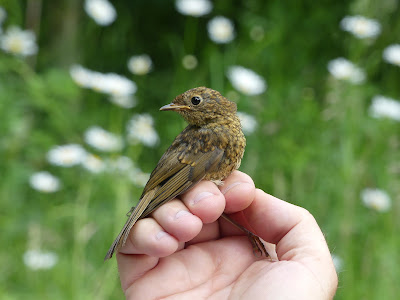Valdi helped with some information for the marshes site. We knew that there had been no snow last winter and fields, usually wet, would be completely dry. Added to this there had been no records of Aquatic Warbler at a regular and usually easy site this year so the chances of the main three marshes specialities of Citrine Wagtail, Bluethroat and Aquatic Warbler may be a struggle with so little water on the fields.
We picked up a few extra species around the villages in the marshes, Kestrel, Rook and Jackdaw having been species missing in the earlier location.
Small Pearl-bordered Fritillary
Efforts here would mostly centre on seeing Citrine Wagtail, Bluethroat and Aquatic Warbler. None would be new to us, but rarely seen unless abroad nonetheless.
We tried a broadwalk that was actually closed. It was terribly dry and there could be no chance of Bluethroat there so resorted to looking at insect life.
Orange Tip
The amount of Mistletoe in deciduous trees was impressive.
We tried some pools around the Russian built Osowiec 2 Fort, finding a few damselflies and some Downy Emerald Dragonflies. We could hear Golden Oriole in the nearby trees and saw a few crossing between clusters of trees.
Osowiec 2 Fort
Downy Emerald
The first true marsh site we tried was a stretch of open area near Mscichy. There was water in the roadside ditch but little across the open area out to the rank vegetation where the Aquatic Warblers might be. We didn't see Bluethroat or Citrine Wagtail. We could catch snatches of Aquatic Warbler song but the birds were very distant and it was impossible to link the song to a distant bird on a stick although we though we had seen at least one poorly.
Singing Aquatic close to the nearest bush on the right was
difficult to see, even with a 'scope.
Mallard
Looking from the bridge at Dobarz we saw some quite close Common Cranes and a foraging White Stork, Green Sandpiper and a Cuckoo. There had been several Cuckoo at Mscichy on our second and evening visit and the reedbed breeders were taking quite a hammering from the parasitic birds.
Common Cranes
White Stork
European Cuckoo
We started the next day at Mscichy again, but not singing Aquatic and only a poor view of a silhouetted Bluethroat. We couldn't say whether it was a red or white spotted form from what we could see. Next, a morning walk by the River Bug brought an excellent View of reeling Savi's Warbler.
Savi's Warbler
River Bug
Trees of the Red Bog
Lily of the Valley
Chris had been checking reports on E-Bird and it looked as though our only chance of decent Aquatic views might be from a certain bridge, so we decided to give it a go. On the way we passed a field, clearly wet and a real contrast to what we were usually seeing with 77 Black-tailed Godwit. We found the bridge and noticed 3 figures off in the distance. Clearly from the habitat, looking from the bridge would be fruitless. Rain was approaching so we donned plastic coats, took the 'scope and headed towards them.
Black-tailed Godwits
We made our way, through a very wet field, one of us without wellingtons got wet feet, and stopped a few metres from the rank vegetation that the Aquatics favour. We heard one before long and tracked it down. A Quail was also heard and six Blue-headed Wagtail seen.
We spoke to the three French birders, having got them onto the Aquatic and got info for a Citrine Wagtail and Bluethroats near their hotel. They had tried the well known Aquatic site just the day before and seen nothing.
Aquatic Warbler
After the rain, this Aquatic site seen from the road.
Little Owl
As we drove back to the hotel it was close to 9:00pm and dark. There were several Woodcock coming out onto the road through the forest.
Our last birding day and we started at the river site by the hotel mentioned to us last night.
Finally, Citrine Wagtail, albeit a female. Swiftly followed by a decent Bluethroat view.
Citrine Wagtail
Male of Bluethroat pair
Our last stop was at the Dluga Luka Broadwalk. This is a well known site where Aquatics are usually seen very close up. Sadly, there had been none seen there this year, in fact the French birders had tried two days before and seen none. We still decided to go to see this quite famous site for the iconic birds. It really looked unpromising as we arrived, but we walked up anyway getting close views of Tree Pipit and Whinchat.
Marsh Harrier
Whinchat
Tree Pipit
Then we caught the unmistakeable song of Aquatic Warbler.

There were two singing males and a female. The three engaged in quite a lot of following one another through the grass and inspecting grass clumps. This was not feeding behaviour but prospecting for suitable nest sites. Ours was the first observation of these birds at this site in 2025.
We let Valdi know as soon as we got back to the car, then began the drive back to Warsaw via a site he had given us for Black Woodpecker.
We managed to locate the nest hole due to a very vocal youngster. We gave it 45 minutes but no adults returned to the well grown chick that seemed to be the last of the young at the nest. It eventually fledged at 13:05pm.
Black Woodpecker nest hole and chick
This site was fantastic with Wryneck, Golden Oriole, Hoopoe, Buzzard, Great Grey Shrike, Tree Pipit and Thrush Nightingale also present.
Finally on our way, there was one more species seen just before we joined the main road, Northern Wheatear. The trip gave us 148 species over 8 days, only one being a lifer for us both.








































































